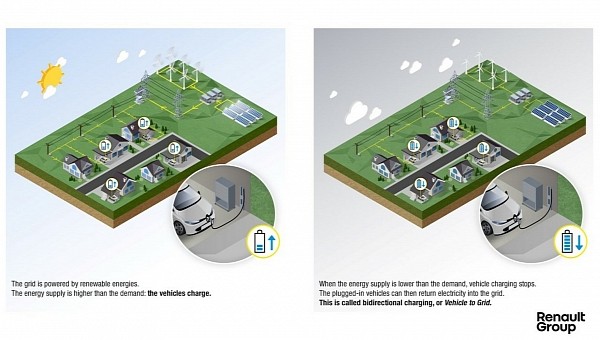Battery electric cars and renewable energy sources could be perfect partners: the battery packs could store energy whenever it is produced and deliver it at peak hours. The only problem with that is discovering who pays the bill when the battery packs have to be replaced. Renault and CEA may have made that more manageable with a new bidirectional onboard charger they have jointly developed and which will reach vehicles by the end of the decade.
The crucial part about the new onboard charger is something that Renault promised but did not explain. According to the French automaker, the new component provides “faster charging of the vehicle while ensuring the durability of the battery.” Anyone looking for anything that sustains what Renault claims about this onboard charger will get frustrated.
Another main advantage of the new bidirectional component is that it reduces energy losses by 30%, and it is also more compact than regular onboard chargers. The top charging speed is about the same as the best currently available in the market: 22 kW in three-phase mode. Having to wait seven more years to see it in vehicles is far from the “soon” Renault said it would take to check how good this onboard charger really is.
Until then, Renault may have time to tell us how the new component protects the battery pack and how much longer it would last if it were a crucial element in a bidirectional system. If you are not aware of how that works, you should before you buy a vehicle with vehicle-to-grid (V2G) capability.
All current battery packs lose capacity as they are charged and discharged. In other words – and following the industry’s jargon – they have a maximum number of cycles (each complete charge the battery packs get). BEVs can use that discharge process to power the motors or a house, or the grid. Vehicles that spend cycles as batteries will run less than if they only used electricity to move around.
Some car companies say battery packs have to retain 70% of their original capability to remain useful in vehicles. Others restrict that to 80%. When a battery pack is no longer suitable for a car, it has to be replaced. Tesla charges between $16,000 and more than $20,000 for a battery pack. Nissan already charged $35,000 for a LEAF replacement.
Who will want to help the grid when they may have to replace a battery pack that costs so much? Most will only use V2G in emergencies to power their homes. If power companies want to use the electricity stored in someone’s car, they must include compensation for the battery degradation V2G will cause. So far, we have not heard of anyone discussing this, as if battery packs could be used indefinitely. When the bill for these components starts arriving, let’s see who will have to pay for new ones – we suspect it will be the EV owner in most cases.
Another main advantage of the new bidirectional component is that it reduces energy losses by 30%, and it is also more compact than regular onboard chargers. The top charging speed is about the same as the best currently available in the market: 22 kW in three-phase mode. Having to wait seven more years to see it in vehicles is far from the “soon” Renault said it would take to check how good this onboard charger really is.
Until then, Renault may have time to tell us how the new component protects the battery pack and how much longer it would last if it were a crucial element in a bidirectional system. If you are not aware of how that works, you should before you buy a vehicle with vehicle-to-grid (V2G) capability.
All current battery packs lose capacity as they are charged and discharged. In other words – and following the industry’s jargon – they have a maximum number of cycles (each complete charge the battery packs get). BEVs can use that discharge process to power the motors or a house, or the grid. Vehicles that spend cycles as batteries will run less than if they only used electricity to move around.
Some car companies say battery packs have to retain 70% of their original capability to remain useful in vehicles. Others restrict that to 80%. When a battery pack is no longer suitable for a car, it has to be replaced. Tesla charges between $16,000 and more than $20,000 for a battery pack. Nissan already charged $35,000 for a LEAF replacement.
Who will want to help the grid when they may have to replace a battery pack that costs so much? Most will only use V2G in emergencies to power their homes. If power companies want to use the electricity stored in someone’s car, they must include compensation for the battery degradation V2G will cause. So far, we have not heard of anyone discussing this, as if battery packs could be used indefinitely. When the bill for these components starts arriving, let’s see who will have to pay for new ones – we suspect it will be the EV owner in most cases.











